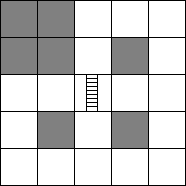hdu 1180 诡异的楼梯【BFS+优先队列】
诡异的楼梯
Time Limit: 2000/1000 MS (Java/Others) Memory Limit: 131072/65536 K (Java/Others)Total Submission(s): 11695 Accepted Submission(s): 2897
Problem Description
Hogwarts正式开学以后,Harry发现在Hogwarts里,某些楼梯并不是静止不动的,相反,他们每隔一分钟就变动一次方向.
比如下面的例子里,一开始楼梯在竖直方向,一分钟以后它移动到了水平方向,再过一分钟它又回到了竖直方向.Harry发现对他来说很难找到能使得他最快到达目的地的路线,这时Ron(Harry最好的朋友)告诉Harry正好有一个魔法道具可以帮助他寻找这样的路线,而那个魔法道具上的咒语,正是由你纂写的.
比如下面的例子里,一开始楼梯在竖直方向,一分钟以后它移动到了水平方向,再过一分钟它又回到了竖直方向.Harry发现对他来说很难找到能使得他最快到达目的地的路线,这时Ron(Harry最好的朋友)告诉Harry正好有一个魔法道具可以帮助他寻找这样的路线,而那个魔法道具上的咒语,正是由你纂写的.
Input
测试数据有多组,每组的表述如下:
第一行有两个数,M和N,接下来是一个M行N列的地图,'*'表示障碍物,'.'表示走廊,'|'或者'-'表示一个楼梯,并且标明了它在一开始时所处的位置:'|'表示的楼梯在最开始是竖直方向,'-'表示的楼梯在一开始是水平方向.地图中还有一个'S'是起点,'T'是目标,0<=M,N<=20,地图中不会出现两个相连的梯子.Harry每秒只能停留在'.'或'S'和'T'所标记的格子内.
第一行有两个数,M和N,接下来是一个M行N列的地图,'*'表示障碍物,'.'表示走廊,'|'或者'-'表示一个楼梯,并且标明了它在一开始时所处的位置:'|'表示的楼梯在最开始是竖直方向,'-'表示的楼梯在一开始是水平方向.地图中还有一个'S'是起点,'T'是目标,0<=M,N<=20,地图中不会出现两个相连的梯子.Harry每秒只能停留在'.'或'S'和'T'所标记的格子内.
Output
只有一行,包含一个数T,表示到达目标的最短时间.
注意:Harry只能每次走到相邻的格子而不能斜走,每移动一次恰好为一分钟,并且Harry登上楼梯并经过楼梯到达对面的整个过程只需要一分钟,Harry从来不在楼梯上停留.并且每次楼梯都恰好在Harry移动完毕以后才改变方向.
注意:Harry只能每次走到相邻的格子而不能斜走,每移动一次恰好为一分钟,并且Harry登上楼梯并经过楼梯到达对面的整个过程只需要一分钟,Harry从来不在楼梯上停留.并且每次楼梯都恰好在Harry移动完毕以后才改变方向.
Sample Input
5 5 **..T **.*. ..|.. .*.*. S....
Sample Output
7
地图如下:

Hint
Hint
这个题难想的地方是原地不动的情况。如果这个情况考虑到了,其实问题也就解决了。
之所以用到了优先队列,其原因就是有原地不动的情况,所以我们这里控制时间最优,使用优先队列。
思路:
从起点出发,控制楼梯方向和走向,然后根据当前走的时间判断楼梯方向,然后走向的方向如果能够顺着楼梯走下去,那就走两次。
这里口述可能并不是很清楚,这里对应代码:
void bfs(int x,int y)
{
memset(vis,0,sizeof(vis));
vis[x][y]=1;
now.x=x;
now.y=y;
now.output=0;
priority_queues;
s.push(now);
while(!s.empty())
{
now=s.top();
//printf("%d %d %d\n",now.x,now.y,now.output);
if(a[now.x][now.y]=='T')
{
printf("%d\n",now.output);
return ;
}
s.pop();
for(int i=0;i<5;i++)//0-右、1-左、2、下、3、上。
{
if(i==4)
{
nex.x=now.x;
nex.y=now.y;
nex.output=now.output+1;
s.push(nex);
continue;
}
nex.x=now.x+fx[i];
nex.y=now.y+fy[i];
if(nex.x>=0&&nex.x=0&&nex.y=0&&nex.x=0&&nex.y=0&&nex.x=0&&nex.y=0&&nex.x=0&&nex.y=0&&nex.x=0&&nex.y #include
#include
#include
using namespace std;
struct zuobiao
{
int x,y,output;
friend bool operator <(zuobiao a,zuobiao b)
{
return a.output>b.output;
}
}now,nex;
int n,m;
int vis[50][50];
char a[50][50];
int fx[4]={0,0,1,-1};//0-右、1-左、2、下、3、上。
int fy[4]={1,-1,0,0};
void bfs(int x,int y)
{
memset(vis,0,sizeof(vis));
vis[x][y]=1;
now.x=x;
now.y=y;
now.output=0;
priority_queues;
s.push(now);
while(!s.empty())
{
now=s.top();
//printf("%d %d %d\n",now.x,now.y,now.output);
if(a[now.x][now.y]=='T')
{
printf("%d\n",now.output);
return ;
}
s.pop();
for(int i=0;i<5;i++)//0-右、1-左、2、下、3、上。
{
if(i==4)
{
nex.x=now.x;
nex.y=now.y;
nex.output=now.output+1;
s.push(nex);
continue;
}
nex.x=now.x+fx[i];
nex.y=now.y+fy[i];
if(nex.x>=0&&nex.x=0&&nex.y=0&&nex.x=0&&nex.y=0&&nex.x=0&&nex.y=0&&nex.x=0&&nex.y=0&&nex.x=0&&nex.y